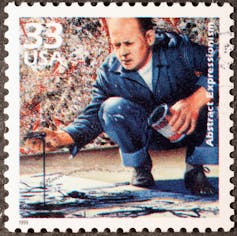asset or overvalued drip painting?
- Written by Sue Rabbitt Roff, Researcher, Social History/Tutor in Medical Education, University of Dundee
Blue poles infinitely winding, as I write, as I write.
Forty-five years ago, the National Gallery of Australia was still a gleam in the eye of Prime Minister Gough Whitlam and the yet-to-be-built gallery’s acting director, James Mollinson. But in 1973 Mollinson’s former boss, Australian art dealer Max Hutchinson, wrote to him from New York, telling him Jackson Pollock’s Blue poles was for sale. New York property mogul Ben Heller ultimately sold the painting to the NGA for US$1.9 million (then A$1.3m). Unusually, the Australian government as buyer paid the dealer’s fee of A$100,000.
This was the highest price paid for an American art work at the time. Owning this abstract expressionist painting, Mollinson and his political supporters said, would put Australia on the international art map – and the NGA said it had almost completed its collection of Australian art. You could perhaps see this as the moment Australia transferred its cultural cringe from Britain to the US.
I asked the now 92-year-old Heller recently why he had sold the painting to Australia. “There’s never a simple answer,” he told me. “I was very close to Jackson and out of the blue I got an approach from Max Hutchinson for Blue poles. I was in possession of knowledge where other things might be going, where the major Pollocks were. This was different and would appeal to Jackson [who had died in 1956] because he had his daring side… This place [Australia] was new, different, not likely to have a Pollock.”
Indeed, the purchase, says Heller, was “a mark of Australia joining Western culture”.
Read more: Here's looking at: Blue poles by Jackson Pollock
An added attraction was that the purchasers were willing to leave the painting on Heller’s apartment wall in New York until the NGA was built (the building was officially opened in October 1982.) This later proved impossible for insurance reasons.
Another attraction may well have been that Heller’s asking price doubled during negotiations with the Australians.
Be that as it may, Blue poles has progressively increased in reputed monetary value over the past 45 years. It was recently reported to have an insurance value of A$350 million. This figure is often cited to justify the purchase even if the aesthetics offend some and the painting’s provenance has been questioned from the outset.
 A postage stamp depicting Pollock at work.
shutterstock
A postage stamp depicting Pollock at work.
shutterstock
In 1974, a meeting had been convened at the National Gallery of Art in Washington to explore whether Pollock’s mates Tony Smith and Barnett Newman had helped to squeeze paint onto the canvas that became Blue poles. Present were Pollock’s widow, Lee Krasner, and gallerist Bryan Robertson, who had given both Pollock and Krasner their first major showings in London. As the NGA website carefully puts it: “The examination revealed that any marks made on the canvas” by those other than Pollock “played no part” in the painting that became Blue poles.
In 2016, Victorian Liberal Senator James Paterson suggested that if Blue poles was worth A$350 million it should be sold to reduce the national debt. His idea was quickly quashed by many, including his party’s own Finance Minister Mathias Cormann, who called Blue poles a “national art treasure”.
(Mind you, as one accountant recently pointed out to me, insurance value of a work of art is often different from the price it might reach on the open market. And upping insurance valuations can markedly increase both premiums and security costs.)
Read more: Here’s looking at: Mike Parr’s Jackson Pollock the Female
Interestingly, as early as 1977 Mollinson told Art News: “I’m sick of it [Blue poles]. It’s not the sort of painting I ordinarily respond to on a personal level anyway. That isn’t what a museum director’s job is necessarily about.”
He thought that when the NGA finally opened in 1982, “We’ll play it down. It’s just one painting – a picture made by a very ordinary person about which a lot of people showed interest at the time we bought it.”
Rather than playing down the controversial painting, in 2015 the then director of the NGA, Gerard Vaughan, said Blue poles was one of the greatest ever American abstract expressionist pictures and had proved to be an excellent purchase.
“It’s the best investment this country has made in anything in my view,” he said.
Still, if it wasn’t for the probably inflated price Australia paid for one of scores of Jackson Pollock’s drip paintings, it might never have become the crowd-drawer it is.
When I asked Heller what he thought of the sums now being talked about in relation to the painting he sold for US$1.9 million 45 years ago, he roared with laughter. “It’s so expensive I don’t want to discuss it!”
Authors: Sue Rabbitt Roff, Researcher, Social History/Tutor in Medical Education, University of Dundee
Read more http://theconversation.com/blue-poles-45-years-on-asset-or-overvalued-drip-painting-102639



